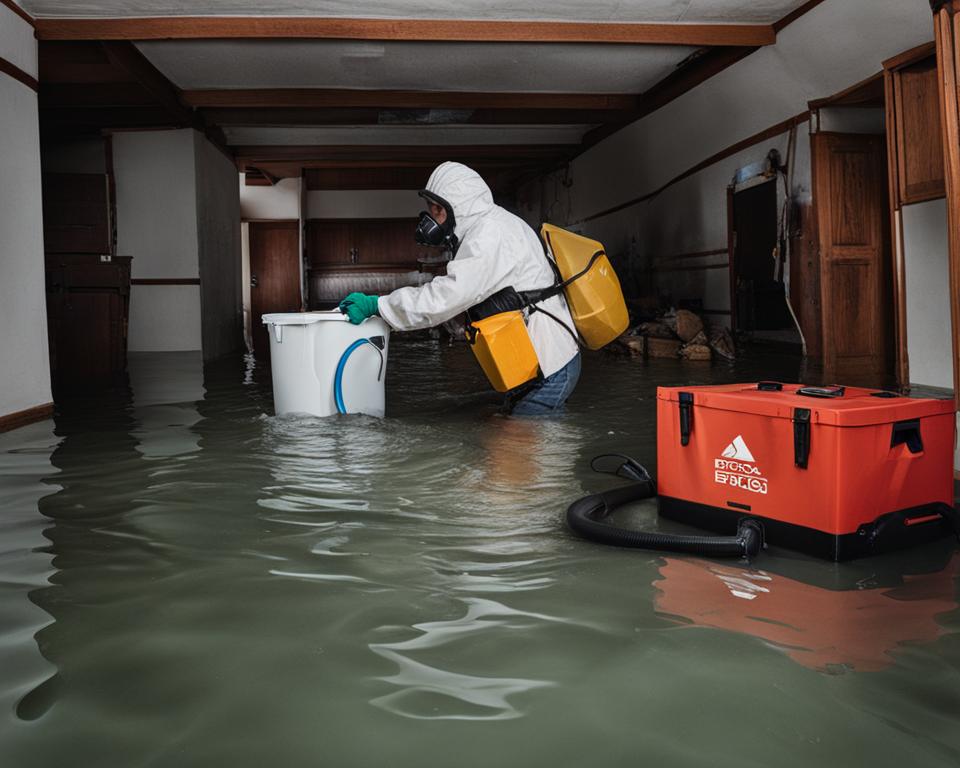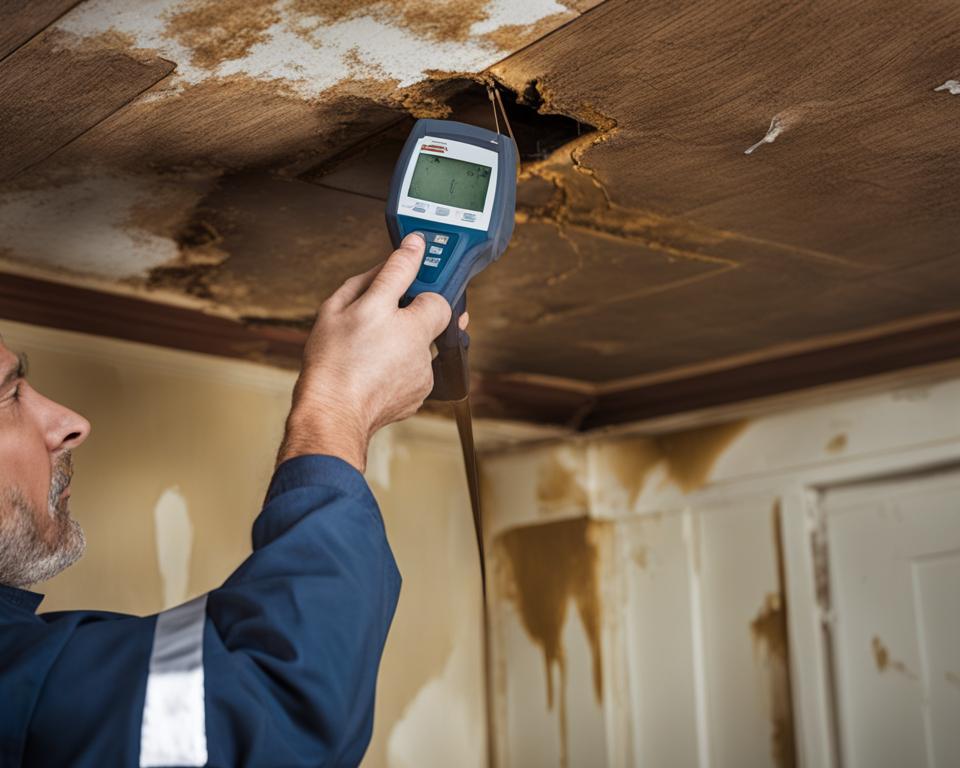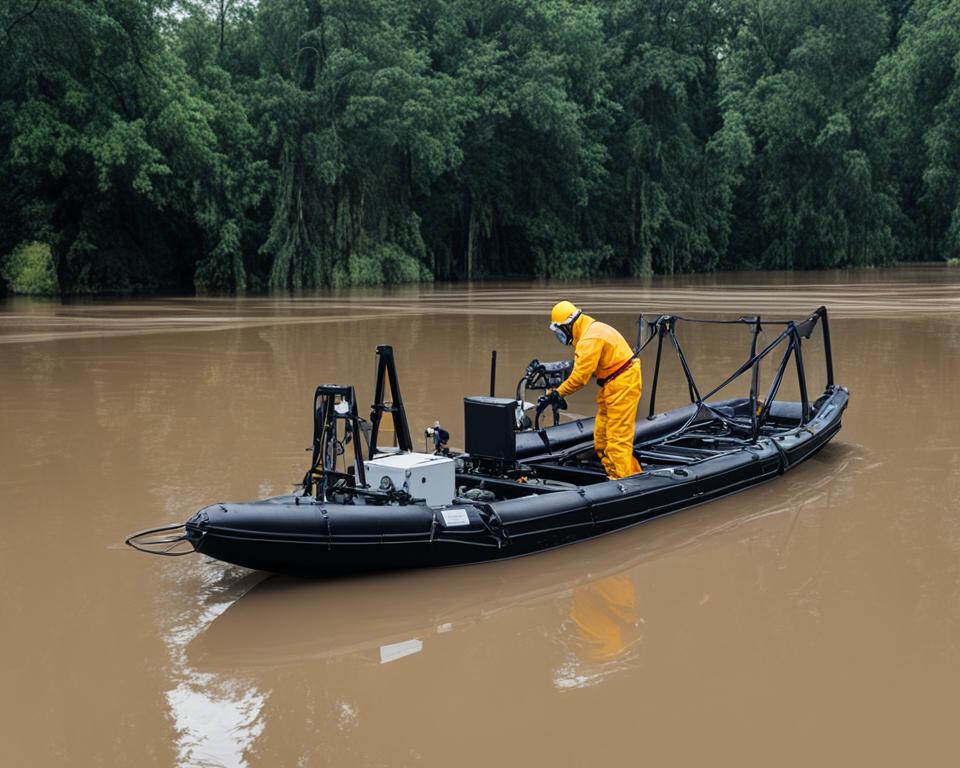Water damage can lead to significant structural and health hazards if not treated properly. It is important to prioritize safety during the restoration process. The Occupational Safety and Health Association (OSHA) provides guidelines for ensuring health and safety during water removal. Restoration professionals undergo training to handle different restoration scenarios safely. Water damage is categorized into three types based on contamination level, and each requires specific safety precautions. Effective restoration also requires the use of specialized equipment such as moisture sensors, air movers, dehumidifiers, air scrubbers, foggers, and generators. PuroClean Emergency Recovery Service New Jersey is a trusted partner in water damage restoration, prioritizing safety and utilizing advanced equipment.
Key Takeaways:
- Water damage restoration requires prioritizing safety and following OSHA guidelines.
- Professionals undergo training to handle different restoration scenarios safely.
- Water damage is categorized into three types, each requiring specific safety precautions.
- Specialized equipment is essential for effective water damage restoration.
- PuroClean Emergency Recovery Service New Jersey is a trusted partner in water damage restoration.
Importance of Water Damage Prevention
Water damage can cause significant harm to your property and lead to costly repairs. By taking proactive measures to prevent water damage, you can protect your home and avoid the hassle and expense of restoration. Here are some effective methods for preventing water damage:
Maintain Plumbing Systems, Gutters, and Downspouts
Regular maintenance of your plumbing systems, gutters, and downspouts is essential in preventing leaks and water intrusion. Inspect pipes for any signs of damage or leaks, and promptly repair them. Clear debris from gutters and ensure downspouts are directing water away from your home’s foundation.
Install Water Alarms and Shut-Off Systems
Water alarms can detect leaks and alert you before extensive damage occurs. Consider installing shut-off systems that automatically turn off the water supply when a leak is detected, preventing further water damage.
Proper Insulation and Ventilation
Inadequate insulation and poor ventilation can lead to condensation and moisture buildup, increasing the risk of water damage and mold growth. Ensure proper insulation in your home, especially in areas prone to moisture, such as attics and basements. Improve ventilation by using exhaust fans in bathrooms and kitchens.
Regular Roof Inspection and Maintenance
Regularly inspecting and maintaining your roof is crucial in preventing water leaks. Check for damaged or missing shingles, cracks in the chimney, and clogged gutters. Promptly repair any issues to prevent water from seeping into your home.
Waterproof Basements and Crawl Spaces
Basements and crawl spaces are particularly susceptible to water damage. Waterproofing these areas can provide an extra layer of protection. Consider sealing basement walls, installing sump pumps, and using moisture barriers in crawl spaces.
By implementing these preventive measures, you can effectively protect your home from water damage and the associated risks. Remember to regularly maintain your property and address any issues promptly to ensure a safe and dry living environment.
| Benefits of Water Damage Prevention | Methods |
|---|---|
| Cost savings on repairs | Maintain plumbing systems |
| Preservation of property value | Install water alarms and shut-off systems |
| Mitigation of health risks | Proper insulation and ventilation |
| Prevention of mold growth | Regular roof inspection and maintenance |
| Promotion of a safe living environment | Waterproof basements and crawl spaces |
Steps to Take for Water Damage Restoration
When faced with water damage, it is crucial to act swiftly and take the necessary steps to minimize further damage and begin the restoration process. Follow these guidelines to ensure an effective water damage cleanup and restoration:
- Ensure Personal Safety: Before starting any restoration work, prioritize safety. Wear protective gear such as gloves, boots, and masks to avoid contact with contaminated water and potential hazards. Additionally, turn off the electricity and water supply to prevent accidents.
- Protect Valuables: Move valuable items out of the affected area to avoid further damage. Prioritize items such as electronics, important documents, and sentimental belongings. Place them in a safe and dry location until the restoration process is complete.
- Remove Standing Water: Use mops, buckets, or wet vacuums to remove as much standing water as possible. This will help prevent additional damage and minimize the risk of mold growth. Take caution when handling electrical equipment near water.
- Promote Air Circulation and Drying: Open windows and doors to improve ventilation. Utilize fans, dehumidifiers, and air movers to encourage air circulation and aid in the drying process. This will help prevent mold growth and facilitate the restoration process.
- Call a Professional Restoration Service: Contact a reputable water damage restoration service to assess the extent of the damage and develop a comprehensive restoration plan. Professionals have the expertise, equipment, and knowledge to handle water damage effectively and efficiently.
Swift action is crucial when dealing with water damage to prevent further issues such as mold growth and structural damage. By following these steps and seeking professional assistance, you can ensure a thorough restoration and minimize the long-term effects of water damage.
| Steps to Take for Water Damage Restoration |
|---|
| 1. Ensure Personal Safety |
| 2. Protect Valuables |
| 3. Remove Standing Water |
| 4. Promote Air Circulation and Drying |
| 5. Call a Professional Restoration Service |

Assessing Water Damage and Inspection
Before starting the restoration process, a thorough assessment of the water damage is necessary. This includes identifying the source of the water and stopping it to prevent further damage. Professionals can determine the extent of the damage and create a plan for restoration.
During the assessment, it is important to inspect the entire property for visible signs of moisture, potential weaknesses in the structure, and the presence of mold or other contaminants. Visual inspections, moisture meters, and thermal imaging can be used to identify hidden water damage.
Inspectors will also check for structural integrity, looking for any signs of compromised foundations, walls, or flooring. They will assess the damage to electrical, plumbing, and HVAC systems, as water damage can affect these components as well.
An inspection report will be prepared, detailing the findings and the recommended steps for restoration. This report serves as a roadmap for the restoration team and can be shared with the homeowner or insurance company as needed.
Timely inspection and identification of water damage issues are crucial to prevent long-term damage and ensure the effectiveness of the restoration process. By addressing the root cause of the water damage and understanding the full extent of the problem, professionals can formulate an accurate plan and execute the necessary repairs.

Drying Out Water Damage
The time it takes to dry out water damage can vary depending on several factors, including the severity of the damage and the materials affected. In general, it typically takes around 72 hours to dry out the affected area, followed by 1-2 weeks for repairs to restore the space to its pre-damaged condition.
During the drying process, specialized equipment such as pumps, vacuums, and dehumidifiers is used to extract the water and expedite the drying process. These tools help remove excess moisture from the air and surfaces, preventing mold growth and further damage. It is crucial to start the drying process as soon as possible to minimize the risk of mold and other issues.
The duration of the drying process may extend for more severe cases of water damage. Factors such as the extent of the moisture saturation, the type of materials affected, and the presence of hidden pockets of water can impact the drying time. Hiring professionals experienced in water damage restoration ensures a thorough and efficient drying process, as they have the expertise and equipment to properly assess, monitor, and expedite the drying process.
Benefits of Professional Drying:
- Expertise and experience in handling various types and severities of water damage
- Access to specialized equipment for efficient water extraction and drying
- Thorough assessment and monitoring of the drying process to prevent mold growth and further damage
- Compliance with safety guidelines to ensure the well-being of occupants and workers
- Efficient restoration timeline, minimizing the disruption to your daily life
By entrusting the drying process to professionals, you can have peace of mind knowing that your property will be thoroughly dried out, reducing the risk of long-term damage and ensuring a safe and healthy environment.
| Factors Affecting Drying Time: | Potential Impact on Drying Time: |
|---|---|
| Severity of water damage | More severe damage may require a longer drying time |
| Type of materials affected | Porous materials retain more moisture and may take longer to dry |
| Extent of moisture saturation | High levels of moisture can prolong the drying process |
| Presence of hidden pockets of water | Hidden pockets of water necessitate thorough inspection and targeted drying |
Dealing with Flood Damage
When it comes to flood damage, prompt action is crucial for restoring homes and minimizing further damage. The first step in dealing with flood damage is to identify the source of the water and, if necessary, evacuate the area to ensure personal safety. Once it is safe to enter, flood water removal becomes the top priority. This involves using specialized equipment to extract and drain the water from the affected area.
Flood water removal should always be carried out by professionals who have the necessary knowledge and skills to ensure effective removal and prevent mold growth and further damage. They have the expertise to assess the extent of the flood damage and develop a comprehensive restoration plan.
Preparation and awareness of flood-prone areas can play a significant role in mitigating the risks associated with flood damage. Homeowners can take preventive measures such as installing flood barriers, maintaining proper drainage systems, and elevating critical equipment and valuables in case of flooding.
Actions for Dealing with Flood Damage:
- Identify the source of the floodwater and evacuate if necessary.
- Contact professionals trained in flood damage restoration.
- Use specialized equipment to extract and drain the floodwater.
- Assess the extent of the damage and develop a restoration plan.
- Prevent mold growth and further damage by implementing proper drying techniques.
Dealing with flood damage requires immediate and professional attention to minimize the impact on the property and ensure a safe and swift restoration process. By taking prompt action and relying on experts in flood damage restoration, homeowners can recover from the devastation caused by flooding.
Risks of Untreated Water Damage
Untreated water damage can have severe consequences for both your health and your property. Here are some of the risks associated with untreated water damage:
- Bacterial and viral growth: Excess moisture provides an ideal breeding ground for harmful bacteria and viruses. This can lead to respiratory problems and other health issues.
- Mold and fungi: Moisture and humidity from water damage create the perfect conditions for mold and fungi to grow. Exposure to mold spores can cause allergic reactions, respiratory problems, and skin irritation.
- Structural damage: Water can weaken the structural integrity of your home or building, leading to sagging ceilings, warped floors, and even collapse in severe cases.
- Property damage: Water damage can ruin furniture, electronics, documents, and other valuable possessions. It can also damage walls, insulation, and electrical systems.
Ignoring water damage and failing to address it promptly can exacerbate these risks and lead to even more expensive repairs in the long run. It’s essential to take action as soon as you discover water damage to minimize the hazards and protect the health and safety of everyone in the space.
| Health Hazards | Property Risks |
|---|---|
| Bacterial and viral infections | Structural weakening |
| Allergic reactions | Furniture and electronics damage |
| Respiratory problems | Document loss |
| Skin irritation | Electrical system damage |
Classes of Water Damage and Insurance Coverage
Water damage can vary in severity, and understanding the different classes of water damage is essential for effective restoration. There are three classes of water damage: Class I, Class II, and Class III.
Class I water damage refers to minimal damage where only a small area has been affected. This typically involves water that does not pose significant health risks and can be relatively easy to clean up.
Class II water damage involves moderate damage, with a larger area affected and the water potentially containing contaminants. This type of damage requires more extensive restoration and precautions to ensure the safety of occupants.
Class III water damage is the most severe, often resulting from flooding or sewage backups. It can pose significant health risks due to the presence of hazardous contaminants. Professional restoration services are crucial for Class III water damage to ensure proper removal and to prevent further damage to the property.
When it comes to homeowners insurance coverage for water damage, it typically includes sudden and accidental incidents, such as burst pipes or appliance leaks. However, it’s important to note that coverage for flood damage is usually not included in standard homeowners insurance. To protect against flood damage, homeowners may need to purchase separate flood insurance.
If you experience any water damage, it’s essential to contact your insurance company promptly to report the incident and understand your coverage. Their guidance will help you navigate the restoration process and ensure proper assistance for your specific situation.
FAQ
What are some safety precautions to take during water damage restoration?
During water damage restoration, it is important to prioritize safety. Wear protective gear, turn off electricity and water supply, and remove valuable items from the affected area. Contact a professional restoration service to assess the extent of the damage and develop a restoration plan.
How can water damage be prevented?
Prevent water damage by regularly maintaining plumbing systems, gutters, and downspouts. Install water alarms and shut-off systems to detect leaks and automatically turn off the water supply. Proper insulation, ventilation, and roof maintenance can also help prevent water intrusion. Waterproofing basements and crawl spaces is another effective preventive measure.
What steps should I take for water damage restoration?
In the event of water damage, take immediate action to minimize further damage. Turn off the water supply, mop up standing water, and promote air circulation by opening windows and using fans. Contact a professional water damage restoration service to assess the damage and develop a restoration plan.
How do professionals assess water damage and conduct inspections?
Professionals assess water damage by identifying the source of the water and stopping it to prevent further damage. They inspect the property for visible signs of moisture, potential weaknesses in the structure, and the presence of mold or other contaminants. Timely inspection and identification can prevent long-term damage and ensure effective restoration.
How long does it take to dry out water damage?
The time it takes to dry out water damage depends on the severity and materials affected. In general, it takes around 72 hours to dry out the affected area, followed by 1-2 weeks for repairs. Professionals use specialized equipment like pumps, vacuums, and dehumidifiers to extract water and facilitate drying. Hiring professionals ensures a thorough and efficient drying process.
How should flood damage be dealt with?
Identify the source of the flood water and evacuate if necessary. Professional flood damage restoration involves extracting and draining the water using specialized equipment to prevent further damage and mold growth. Preparation and awareness of flood-prone areas can help homeowners mitigate the risks associated with flood damage.
What are the risks of untreated water damage?
Untreated water damage can lead to the growth of bacteria, viruses, molds, and fungi, which can cause respiratory problems, skin irritation, and other health issues. It can also cause damage to property, possessions, and the integrity of the structure. Prompt water damage repair is essential to mitigate these risks and protect the health and safety of occupants.
What are the classes of water damage and does homeowners insurance cover it?
Water damage is categorized into three classes based on severity. Class I, II, and III represent different levels of damage. Homeowners insurance typically covers sudden and accidental water damage, but flood damage may require separate flood insurance. It is important to contact your insurance company to understand your coverage and report any water damage promptly for proper assistance.

Leave a Reply